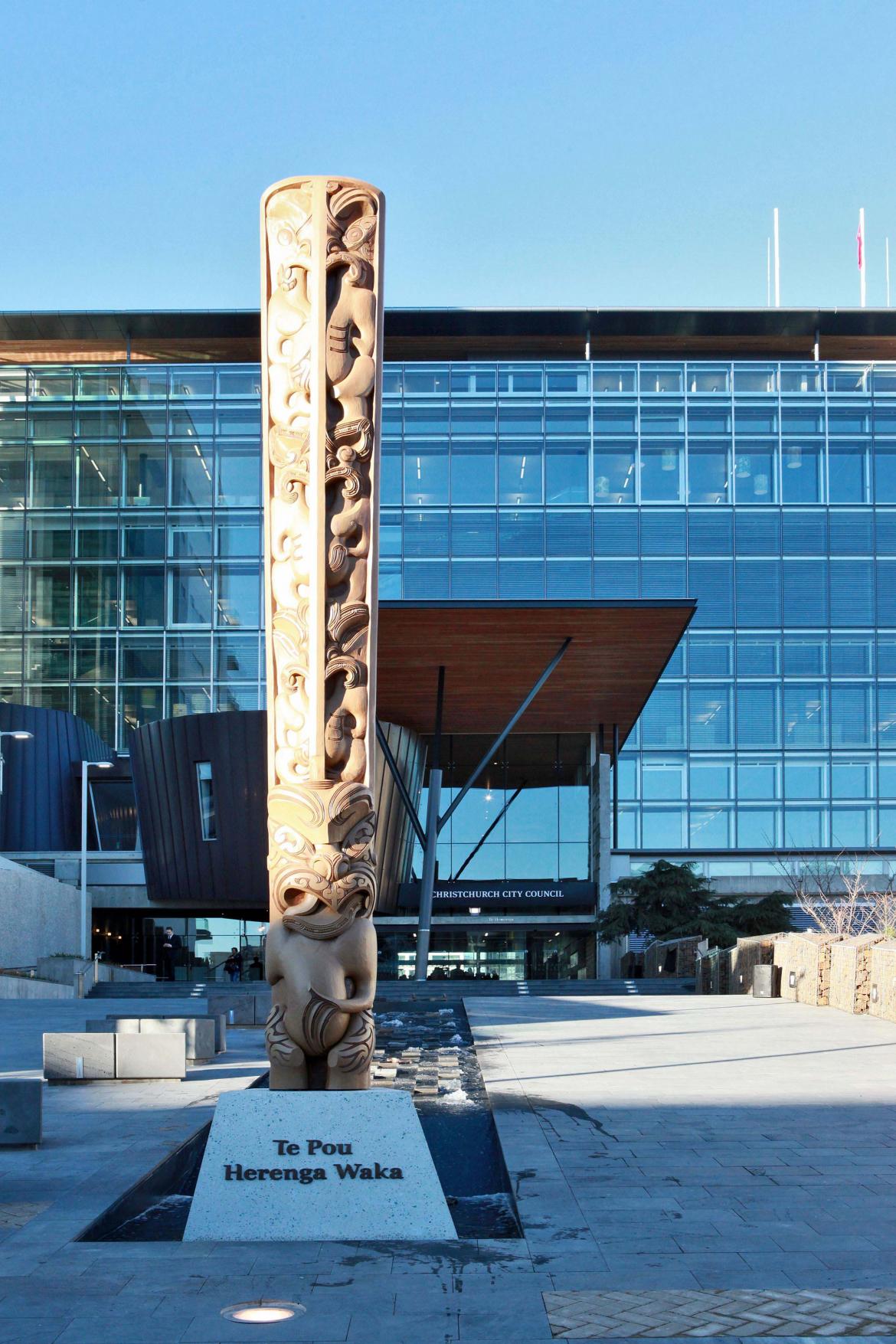Green Building

NZ Green Building Council updates the Steel Credit in Green Star NZ to something achievable.
If you build upmarket offices, commercial buildings or schools this should mean something to you. If it does read on to discover how we have finally made the steel credit applicable to NZ made steel. If this means nothing, read on to discover why you should know about it. You can now use steel made in New Zealand to obtain Green Star points.
Much of the general information about Green Star that follows is provided with much more detail, and more effusively, at the NZ Green Building Council website, www.nzgbc.org.nz., pages https://www.nzgbc.org.nz/Category?Action=View&Category_id=292 and connections, so this is just a summary with particular reference to the Steel Credit - MAT 8, and some of the lengthy history. I have taken some material from this website, thanks NZGBC.
Sustainable development
Back in the 1980s the UN, concerned about the even-then obvious diminution of natural resources appointed the Brundtland Commission to report on the issues. From this came the still valid definition of sustainable development as “development that meets the needs and aspirations of the present without compromising the ability of future generations to meet their own needs”. Thus, sustainable development is the organizing principle for sustaining the finite resources necessary to provide for the needs of future generations of life on the planet.
Building Sustainability
In our modern landscape, even in rural New Zealand where agricultural activities have a significant effect on the overall sustainability of the country, one of the most important and long-lasting things affecting “development that meets the needs and aspirations of the present without compromising the ability of future generations to meet their own needs” is buildings, particularly
non-residential buildings.
Hugely expensive in use of resources, energy gulping during life, and affecting the environment for many decades (at least as planned), how we build and inhabit buildings has a big effect on the overall sustainability of society. So does what happens to the buildings and their materials once their life is over.
Soon after this Commission reported, people started looking at ways to assess the design and construction of large buildings and developed ways of assessing their sustainability in a rational and repeatable way, so that standards could be set and individual designs created based on these standards, and able to be compared to the standards.
Green Rating schemes
Starting in the 1990s with BREEAM (1990) in the UK, LEED (2000) in the US, and others such as CASBEE in Japan, Australasia followed with the Green Star programme in Australia in 2003 and then Green Star in New Zealand in 2007.
Use of Green building rating schemes
All of these rating schemes, or at least the ones we have looked at, are to do with the “greenness” or sustainability of the building during building and during the building’s life. The sustainability of a building is created by considering various factors which contribute to the overall sustainability of the building during its creation and life. The building is what is rated, not the products. Products are only of note when they impact on the sustainability of the building.
Scope
Scope All of these schemes seem to have followed the same path. NZGBC started with Office Building Design, then Office Design and Build, then Interior Design and Build, and eventually they developed a version for Homes, NZ Homestar. NZ also has a specific tool for Educational and Industrial Buildings.
The term “Green Building” (or maybe “Building Green” is better) brings together a vast array of practices and techniques to reduce and ultimately eliminate the impacts of buildings on the environment and on human wellbeing. But, effective green buildings are more than just a random collection of environmentally friendly technologies. They require careful, systemic attention to the full life cycle impacts of the resources embodied in the building and to the resource consumption and pollution emissions over the building’s existence. The aim of the rating process is to encourage the design and construction of sustainable buildings and improvement by innovation, and allow recognition of this by ranking.
Green Star NZ
Green Star NZ is a tool that rates and communicates the sustainability of New Zealand’s commercial buildings. Green Star NZ was adapted for NZ from the Green Star programme developed by GBCA (Green Building Council of Australia). Green Star can apply to any non-residential building. There are specific tools to rate office, industrial and education buildings, as well as interior fit-out projects. Green Star can also be customised for other building types, such as hospitals and libraries.
A building can achieve a rating of:
n 4 Green Star - Best Practice
n 5 Green Star - New Zealand
n Excellence 6 Green Star - World
Leadership
A Green Star assessment can be undertaken in both the Design and Built phases of a project. Design ratings occur earlier in the project, and are followed by Built ratings after completion to confirm the project has actually implemented the features that gained points for the Green Star Design rating.
To rate a building’s overall environmental impact, the tool awards points across nine categories: energy, water, materials, indoor environment quality (IEQ), transport, land use & ecology, management, emissions, and innovation.
Materials
Products and Materials relate to Green Star in two different ways:
In the Green Star Materials category, which make up 10% of the points available in Green Star, credits set out criteria to address environmental issues with key building materials. Where these criteria are fulfilled points are awarded. This category tends to look at how the material itself has a reduced impact on the environment.
Steel
Globally the use of steel in a building (which includes reinforcing steel, structural steel and of course steel framing and wall and roof cladding), is covered in different ways. The allocation of possible points seems to depend on the steel industry in the country involved.
Green Star as originally developed in Australia concentrated on recycled content of the steel used in the building and the reuse of steel materials (e.g. steel beams).
In the first two versions of New Zealand’s Green Star the steel credit read -
Note that the title was “Recycled content of steel” up to 2009. Then it changes to “Steel” but the content is the same.
Those who understand the NZ steel process will immediately see that any steel made by New Zealand Steel will not qualify. If you do know why, skip the next bit.
Steel making and recycled content
Steel is made by one of two processes - Basic Oxygen Furnace (BOF) or Electric Arc Furnace (EAF). These use different amounts of recycled steel (as opposed to virgin iron) as the raw material for the process. There are limits to the amount of recycled material that BOF can use but EAF can use up to 100% and relies on a minimum (30%) in order to even start the arc.
Until 2014 we had two steel makers in New Zealand and the system had evolved where NZ Steel (BOF) used up to 10% pre-consumer recycle (i.e. internal scrap), and no post-consumer recycled. Pacific Steel (EAF) used scrap exclusively. This meant that structural steel and coil steel for cladding and framing made in New Zealand could not get any Materials credits. Reinforcing steel did get credits for recycled content.
This situation did nothing to reward sustainable production of steel in spite of a sustainable manufacturing process (as reported in Scope). In fact the recycled credit just rewards the status quo and does not really encourage sustainable behaviour, which is an important part of the rating system concept.
Since 2014 there has been only one steel manufacturer - New Zealand Steel, owned by Bluescope Steel, which makes steel (including reinforcing steel previously made by Pacific Steel) only from ironsand at Glenbrook. So there were now no credits at all for NZ made steel. But you could import used corrugate from Asia, of any quality, and receive a credit for it.
Sustainable Steel Council Not surprisingly manufacturers and downstream processors of NZ made steel (basically NZ Steel and NZMRM and NASH) were not happy with this situation. And building designers were not encouraged to use NZ made steel and get Green Star points for doing so. While 3 points out of 24 to a total of 10% may not seem a big deal, it would still be possible to get an extra point or two in a green building in order to move up a star rating. In any case we were offended that our very sustainably manufactured and sustainably processed steel was accorded no recognition while any recycled rubbish was.
In 2009 we formed the Sustainable Steel Council (now a part of Metals NZ Inc) at http://www.sustainablesteel.org.nz/ to promote the sustainable properties of our products (e.g. fully recyclable) and primarily to try and persuade the NZ Green Building Council to recognise our industry by providing achievable Green Star credits.
The process has consisted of repeated lobbying NZGBC about the sustainability of NZ steel production and downstream processing. We have had various proposals discussed, and during this time GBCA has changed the Australian steel credit to recognise sustainable manufacturing and remove recycled content. We contributed to the Christchurch specific rating tool (BASE). At all times we have been conscious of the need for the rating/credit to drive improvement and innovation not just to recognise the status quo (as some proposed changes would have).
Finally after Pacific Steel closed its scrap-using plant and now all NZ steel scrap is exported and all steel production is at Glenbrook using ironsand with no external scrap used, we have had some success.
Finally!
The 2015 Green Star v3 Steel credit
MAT-8 Steel now has as its aim: “To encourage responsible sourcing and the reduction of environmental impacts of steel building materials” and has as a Prerequisite Criteria (sic): “Responsible Sourcing
It is a prerequisite to the achievement of any points in this credit that at least 90% of the steel used in the building is sourced from a Responsible Steel Maker”.
Those of you who have stuck with me so far will see this is very different to the original versions (quoted above).
This, now published, has been through a number of similar but different versions during 2014 and 2015 and it is thanks largely to the persistence of SSC chairman Dr Stephen Hicks from HERA that we have the version we now have. You can download the MAT-8 v3-0-0 credit from the NZMRM website.
Basically the steel credit requirements have changed from requiring recycled content at high levels to;
a) “responsible sourcing” (a prerequisite) - defined as;
“To be considered a ‘Responsible Steel Maker’ the steel making facilities from where the steel for the project is sourced must:
n Hold a valid ISO 14001 Environmental Management System (EMS) certification or Enviro-Mark NZ Diamond level certification AND n Be a member of the World Steel Association’s (WSA) Climate Action Programme (CAP)
n Where Stainless Steel is used, the stainless steel manufacturer must be a member of the International Stainless Steel Forum’s (ISSF) Sustainable Stainless Charter.”
And then
b) ‘Product Sustainability’ which comes from;
n Reused products
n Third Party Certification
n Stewardship Programmes
n CarboNZero
n Declare
n CEMARS product certification
(EPD was in this list at one point, but has been moved to “Innovation” which has somewhat different rules)
And
c) ‘Responsible Industry’ which is defined as;
To be considered a ‘Responsible Steel Fabricator/Processor’ the steel supplier must:
n Hold a valid ISO 14001 Environmental Management System (EMS) certification or Enviro-Mark NZ Diamond level certification.
n Enviromark Gold and Platinum will be recognised with a 75% weighting.
n Points are calculated by completion of the Green Star Materials Calculator.
And
d) finally we have Innovation;
“The Innovation category aims to encourage and reward innovative and sustainability initiatives within the construction industry . Generally this recognises innovation and achievements that are not covered by the scope of Green Star or beyond the requirements of Green Star”
Summary
The Green Star building rating system aims to recognise sustainable building by awarding Stars. A small number of points towards this come from Material selection. Although this is not the case in some systems, Green Star in Australia and then in New Zealand awarded points for steel only for use of recycled content. Because of the manufacturing processes used in New Zealand this meant that steel made by NZ Steel at Glenbrook was not eligible for any points, although reinforcing steel made by Pacific Steel was. The Sustainable Steel Council spent many years lobbying against this, and suggesting that the scheme should aim to reward sustainable sourcing. GBCA changed the Australian Green Star rating to recognise sustainable manufacture and removed recycled content, in 2012.
Eventually, shortly after all steel production in New Zealand was located at New Zealand Steel and no scrap steel was recycled in NZ, the change was recognised by NZGBC to be needed and after over 12 months of discussion and a number of widely varying versions we have MAT-8 v3-0-0 which removed the need for recycled content and recognises both sustainable steel production and sustainable use of the steel in production processes.
The author, Stuart Haymen, was once a Green Star Accredited Professional (GSAP) to learn all about this slightly esoteric stuff.
Note that the very nice looking Green Star rated buildings shown here, although using steel, would have gained no points for using NZ-made steel. Now they and similar buildings can.



